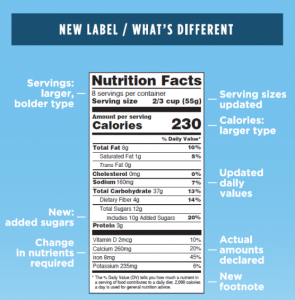Eating healthy starts with buying healthy foods. When buying your groceries, you can use the Nutrition Facts label on packaged foods to help find the best food choice.
As you may have noticed, the Nutrition Facts label looks a little different than it used to. This is because the Food and Drug Administration (FDA) made some helpful changes to the food label. Some of the changes include: making serving size and servings per container appear larger, making calories appear larger and in bold, and stating whether a food has added sugars in it. Some manufacturers have begun changing the Nutrition Facts label to the new format while the rest have until January 2020 or 2021, depending on the company’s annual sales, to do so.
Given the changes to the Nutrition Facts label, now is a good time to review how to use it to help guide your food choices.
Where to start?

The Nutrition Facts label on packaged foods starts by telling you how many servings are in the container and what the serving size is. The rest of the information on that label is for the serving size specified at the top. In this example, the serving size is 2/3 cup. You can expect to get eight servings, 2/3 cup each, from this package.
Next, we can look at the number of calories in 2/3 cup of this food. Here we see that 2/3 cup of this food has 230 calories. The new label has this in big, bold letters to make it easier to identify.
Below the calories, we find information on the main nutrients found in this food.
The Middle Section
The Nutrition Facts label tells us information about the amount of fat, cholesterol, and sodium in this food. Experts recommend choosing foods that are low in Saturated Fat, Trans Fat, Cholesterol and Sodium, as these are linked to higher risks of diseases such as heart disease. Below those items we want to limit, we find Total Carbohydrate in bold. This number is important for diabetics to notice if they are counting carbohydrates. Under Total Carbohydrate, we have Dietary Fiber, Total Sugars and Added Sugars.
We all need fiber in our diet to keep us regular, make meals feel filling, and protect us against certain diseases. Women should aim for 25 grams of fiber per day while men should aim for 38 or more. Meanwhile, sugar is considered to be an “empty calorie,” and is something we want to limit. Since Total Sugars now specifies Added Sugars, we can tell exactly how much sugar was added to this food. If the product was to list 12 grams of total sugar and 0 grams of added sugars, then it would be a product with naturally occurring sugars (perhaps containing fruits or milk). We want to choose items low in added sugar.
Lastly, we have the grams of Protein. Protein is essential in maintaining or building muscle mass and should be part of our daily diets.
The Bottom Section & the 5/20 rule
At the bottom of the Nutrition Facts label, we find a list of vitamins with a % daily value. The vitamins listed here are known to be of high importance to our health, and typically lacking in adequate amounts from the average American diet. The footnote at the bottom tells us the % Daily Value is how much a particular nutrient in one serving of that food contributes to the total amount needed, recommended, or allowed of that same nutrient based on a 2,000 calorie diet.
 If you want to figure out if a food is high in or if it has a lot of something, you look at the % Daily Value on the right. If the number is 20% or greater, then the food is high in that nutrient. Similarly, if your goal is to find a food low in a particular nutrient, or that does not contain a lot of this nutrient, you want to look for 5% or lower on the % Daily Value.
If you want to figure out if a food is high in or if it has a lot of something, you look at the % Daily Value on the right. If the number is 20% or greater, then the food is high in that nutrient. Similarly, if your goal is to find a food low in a particular nutrient, or that does not contain a lot of this nutrient, you want to look for 5% or lower on the % Daily Value.
The Takeaway
Use the Nutrition Facts label to help guide your food choices. First, identify the serving size for a particular food. If you are likely to eat more than what is listed, you will have to multiply the amount of each nutrient by the number of servings. For example, if you ate three times as much of a listed serving, then you would multiply everything on the label by three. Food choices that seemed healthy based on one serving may not be so if multiplied to the total number of servings consumed.
Look for foods that are high in vitamins, meaning they have a large (20% or greater) percent daily value. At the same time, look for foods that are low (5% or less) in nutrients we need to limit for our health, such as saturated fat, trans fat, cholesterol, sodium, and added sugars. Finally, use the Nutrition Facts label to look at the grams of fiber, total carbohydrate, and protein, and determine if eating that food will help you reach your daily goals.
 0
0
